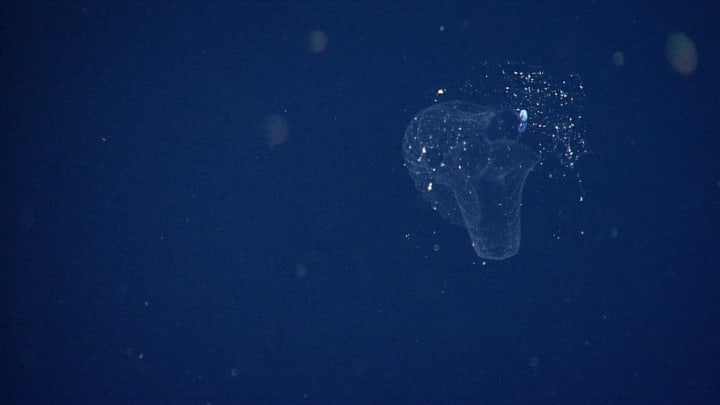There’s so much in our oceans we have yet to explore—in part because life down there is so weird that we can’t even figure out how to study it. Now scientists have made some progress with new technology that lets them peek inside one strange animal’s floating, goopy house. The team described their progress in the journal Science Advances.
The giant larvacean (genus Bathochordaeus) is a bizarre critter. Unlike better-known filter feeders like baleen whales, Bathochordaeus has a little mouth, so it’s taken to outsourcing the actual filtration process. Every day, the larvacean blows an enormous, sticky mucus balloon, which snags all kinds of morsels as the animal drifts through the water column.
Each trapped morsel contains a little bit of carbon. After the larvacean eats its fill, it discards the now-cluttered snot bubble, which sinks, thereby bearing some of that carbon out of circulation and onto the sea floor. These delicate mucus houses are quite beautiful, in their way. But they’re also kind of a pain to study, as they tend to disintegrate at the slightest touch. Grabbing one in a net or jar has proven almost impossible.
Oceanographers at the Monterey Bay Area Research Institute (MBARI) decided to take a more hands-off approach. They adapted a technology called particle image velocimetry (PIV), which is commonly used to study the movement and flow of water. They attached a PIV laser and a camera to a miniature remotely operated vehicle (ROV) and sent it down, down, down into the depths off the California coast. When the ROV’s camera spotted a larvacean, the researchers activated the laser, which spread a sheet of light over the animal and its dwelling, illuminating every particle within.
“We were all shocked by how well it worked,” principal engineer Kakani Katija said in a statement. “There was a lot of oohing and aahing in the control room. It wasn’t just the scientists who were shocked and amazed—it was everyone on the research vessel.”
The researchers are excited to apply their new technology to all kinds of deep-sea research.
“Now that DeepPIV is available to the oceanographic community,” Katija said, “it opens up all kinds of possibilities.”
